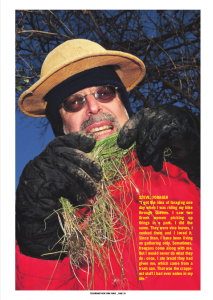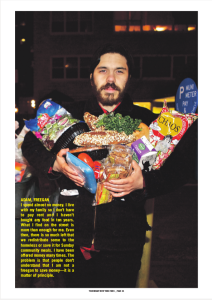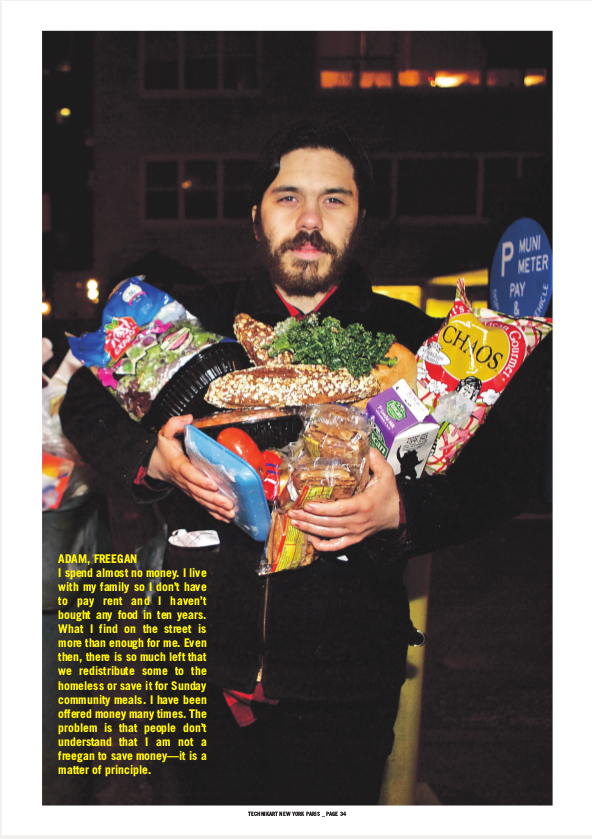 THEY ARE CALLED FREEGANS,
THEY ARE CALLED FREEGANS,  LOCAVORES, GUERILLA GARDENERS AND THEY ARE THE LATEST NEW YORK SENSATION. FOR THESE URBAN FREAKS, THE FIGHT AGAINST GLOBALISATION BEGINS IN OUR PLATES. TO GET A GRIP ON THE PHENOMENON, WE TRACKED THEM DOWN IN THE BIG APPLE. IS FRANCE THE NEXT STOP ?
LOCAVORES, GUERILLA GARDENERS AND THEY ARE THE LATEST NEW YORK SENSATION. FOR THESE URBAN FREAKS, THE FIGHT AGAINST GLOBALISATION BEGINS IN OUR PLATES. TO GET A GRIP ON THE PHENOMENON, WE TRACKED THEM DOWN IN THE BIG APPLE. IS FRANCE THE NEXT STOP ?
THE LOCAVORES
In a recent episode from Law and Order, Robin Williams played the part of a suspect charged with an offence committed against a fast-food outlet, who defends himself with a shock alibi : he is a “locavore” … You might as well say that the word, elected word of the year in 2007, has relegated the organic movement to a sectarian position and nipped in the bud the very trendy “carbon neutral” fashion although it was spreading in Hollywood. The buzz is so strong that the Google M.D.s, who are not really known for being green fanatics, have turned the head office cafeteria into a local restaurant, which was given a new name on that occasion–
Café 150. 150 is the golden number for locavores, who are supposed to eat only what has been produced within 150 miles at most. Why ? Because of the “carbon impact”, the well-known unit measure which shows you care about future generations. The principle is quite simple : forget about hunting pesticides-which is so 90s–the time has now come to rail against carbon dioxyde by boycotting anything that needs (too much) fuel to get to your plate. There is one problem, though : come winter time in New York, finding anything but
roots around one’s home is quite a feat. So following a strictly locavore diet is the ultimate trip which makes you one of the leaders of the movement, such as Alisa Smith and J.B. McKinnon. Those two Canadians explain in their book—A 100 Mile Diet, which has become the locavore Bible—how they spent one year
feeding on berries and corn. The experiment was not a smooth ride—they had moments of madness and depression, arguments and shameful cravings for junk food—but they made their point : yes they can !
JARS AND CANS
Leda Meredith too went down this initiatory path. She became the star of the community by feasting frantically on tubers and posting notes on her blog about her everyday menu for a year. We meet up with her in Park Slope, a Brooklyn district which is home to the underground gay scene. In this area which has become, like Williamsburg, the private kingdom of bourgeois bohemians and hipsters (pierced under-twenties who are all part of—at least—one rock band) people pack in the local restaurants at brunch time. Leda, a smiley urbanite, looks more like a zen ethical shopper than a carbon footprint ayatollah.
“People are in the habit of rushing to supermarkets to buy food, without really wondering where the things come from, she explains. Being a locavore makes it possible to remain connected to nature and think about what makes us alive.”
Her apartment is crammed with jars and cans—the survival kit for winter, those four, slightly tense months when you try to make that one pizza last and your friends turn away from you because the fridge’s empty. In other words, going locavore is a chance to rediscover, in these days of overconsumption, the good old virtues of frustration : “Kids used to have oranges for Xmas and that made their day. That’s sort of the locavore spirit.”
But, despite the fact that some of the trendy intelligentsia have joined the movement—such as cartoonists Jessical Abel and Matt Madden, a couple who organize local dinners once a month–, locavores are not that popular. Because calculating the carbon footprint of beets depending on their place of origin could be hot air, as journalist Joel Stein, from Time, asserts. Joel defines himself as “a locavore with many exceptions” and has lately organised a “distavore” counter dinner at his place, serving food which had travelled at least … 3,000 miles. Was that mere provocation ? « Some studies have proved that eating local food does not necessarily consume less energy, he says with a laugh. Tomatoes which have been shipped from Spain, for example, are much more carbon neutral than those which have been carried by truck over 6 miles.”
THE FREEGANS
Manhattan, 10pm, on 3rd and 86th, in very chic Upper East Side. About twenty people are pacing up and down in the cold in front of the garbage cans of a hypermarket. Other journalists are standing about. CNN cameras are looming—the channel has ordered a documentary. Indeed the “freegans”—which is a contraction of “free” and “vegans”—have lately become the US media’s darlings, especially because of their favourite activity : dumpster diving.
For those activists, who believe in a new age type of marxism with degrowth inspiration, shopping at a supermarket is the equivalent of going to… Auschwitz. Their credo–over-consumption has brought about a decline which is comparable to that of the Roman Empire, and we all contribute to it when we load up our caddys. As a consequence, those working boys and girls, who often have respectable jobs and wear neat clothes during daytime, fish for their food in dumpsters alongside bums at night.
MUFFINS FROM THE TRASH CAN
Adam Weissman appears, roller-skating at full speed. The 29-year old leader of the movement — with the complete anti-globalisation outfit and a vague resemblance to the Che–, gives the kind of talk that would make José Bové look like a centrist representative : “My mother died in a Nazi camp. I think we are all responsible for what happened over there, because no one said anything. We have to stop supporting the system.” He mentions Thoreau and the English Luddites, those nineteenth-century workers who broke their machines. And he gives figures, which he tirelessly repeats in front of cameras : every year, 40 % of the food produced in the United States is thrown out while it is perfectly edible. Theory is put to the test and the round begins. Janet, one of the pioneers of the movement, harangues the rank and file and gives away her best spots : where to find
cakes, pizzas, thaï sauce, and even organic squash. A good pedagogue, she begins with easy stuff for the newcomers : the trash cans outside a Dunkin Donuts shop. After thirty seconds at most, she triumphantly pulls out a bag of muffins which she waves about as proudly as if she had made them herself : “Look how beautiful they are, all soft on the inside !” Passers-by stop and stare. “I wouldn’t mind jumping in with all those vegeterian chicks, but it’s 20°F”, says Ron, a cab driver wearing a hat and a red parka.
THE WILD FORAGERS
Although not everybody is ready to hit the garbage dump, it does seem that not eating out and not buying groceries anymore are becoming essential features of the New York lifestyle. The success of Cathy’s blog is
enough to prove it. In “Not eating out in New York”, she gives a list of all the places where you can get bad and free food in the city. “I got this idea from my media studies teacher at university. He imposed a media fast on us, forbidding us to read the press or watch TV for three months. It did me a whole lot of good. I have been trying to reach that state of abstinence again by not buying food anymore while living in New York.”
As opposed to their predecessors from the 70s, the challenge for these food warriors consists in proving that their diet is adapted to urban life, that it enables them to maintain a social life and even to make new friends through the community forum. Gone are the days when living in the wilderness was idealized. All of them are urbanites who would move to the countryside for nothing on earth.
PICKING BERRIES IN CENTRAL NEW YORK
Even better : for them, the city is the ultimate spot to unearth our pre-civilisation roots. Or at least, so says Steve Brill, aka “Wildman”, the leader of the “wild foragers”, who feed mostly on what they pick, in this case berries and plants from New York parks. Really ?
“Yes, you can find more things than in the forest. For one thing, wild animals eat everything, and, the undergrowth is less diverse because of the lack of light.” He adds : “Should there be a famine, modern populations would not survive.” Thus, every week, Steve and his followers engage in picking berries and plants right in central New York. The activity is seldom understood by the local cops, who once questionned him rather brutally while he was peacefully chewing on dandelions in Central Park.
THE GUERILLA GARDENERS
For those who may find that in the end nature has little to offer when you are starving, there remains one last solution : “guerilla gardening”. Or : growing what you feel like eating yourself, wherever possible. This trend blossomed in New York in the 70s and was given fresh impetus in 2004 by Richard Reynolds, who launched a site which has united green rebels from around the world. An ad executive in the daytime, Richard spends the night throwing “seed bombs” in the most inaccessible places, which he harvests after nature has done its job. But the main thing is the thrill of the illicit raid : “We are modern warriors, says Richard, showing off a little bit. We have nothing to do with the hippies’ “flower power”. Those guys dreamed of a better world on acid. Whereas we want to use plants to fight against the general apathy that society encourages, the type that leads you to passively switch on your TV when you get home at night.”
This struggle gave birth to real urban vegetable gardens in New York, some of which have become institutions over the years : community gardens, that is to say gardens managed autonomously by neighbour communities. A guerilla beekeeper has even put hives on the roofs of Manhattan and collected urban honey. But the ultimate goal of this nice & green Third International is—of course—to pull down boundaries. During the White Night in Paris in 2008, Richard planted asparagus in a flower bed near the City Hall. “Guerilla gardening is comparable to tagging, except it is something alive that may be eaten. The stakes are the same : leaving one’s mark in the anonymous city.”
BY MARJORIE PHILIBERT – PHOTOS ANDRIUS SCHMID
“SECT-LIKE”
THE AUTHOR OF “THE HYPERMODERN EATER” AND AN URBAN ECONOMY SPECIALIST, FRANÇOIS ASCHER BRISTLES WHEN SOMEONE MENTIONS FOOD WARRIORS. WHY IS THAT ?
FRANÇOIS ASCHER, WHAT IS YOUR TAKE ON FOOD ACTIVISTS ?
We are facing a sect-like social phenomena. Indeed, those groups break away from mainstream social practices, they proclaim their difference and are often very proselytic, which means that the will to convince others progressively takes over individual practices. These movements are based on a scientific approach, with studies and figures to back their claims, but they urge people to adopt irrational behaviours, which lean towards control obsession. Today, eating is becoming increasingly politicized, because globalisation is so powerful that it is making itself more and more visible in our everyday lives, even in our plates.
ARE THEY AHEAD OF THEIR TIME ?
Quite the opposite. This behaviour is a way of resisting today’s hypermodern eating patterns. A hypermodern eater is someone who is capable of using the multiple choices which globalisation has made possible : today, we can eat organic or fair trade products, at home or in fast-food outlets … Knowing what we are going to eat has become a constant issue. And indeed there are so many injuctions that sometimes it makes life almost impossible. So certain people have decided to simplify the injunctions by narrowing down their choices. Confronted with the upheaval of landmarks caused by globalisation, they have recreated a fantasmatic territory based on nostalgia for traditional territories. It has become important to belong “somewhere” and to eat apples coming from that “somewhere”. It is a perfect niche for marketing, in so far as every one responds more or less positively to homeland.
SO, WHAT’S THE FUTURE LIKE FOR THOSE MOVEMENTS ?
These phenomena affect social classes which have some control over their time, that is to say well-off and idle people. This is one of the reasons why they are doomed to remain a very small minority. That being said, due to the growing recession, they can take new political shapes and lean towards autarkical practices. But the movements inspired by degrowth theory like the freegans cannot find a political audience in a context of recession and restrictions.
Reading : «LE MANGEUR HYPERMODERNE» (ODILE JACOB, 2005).
INTERVIEW M. P.


